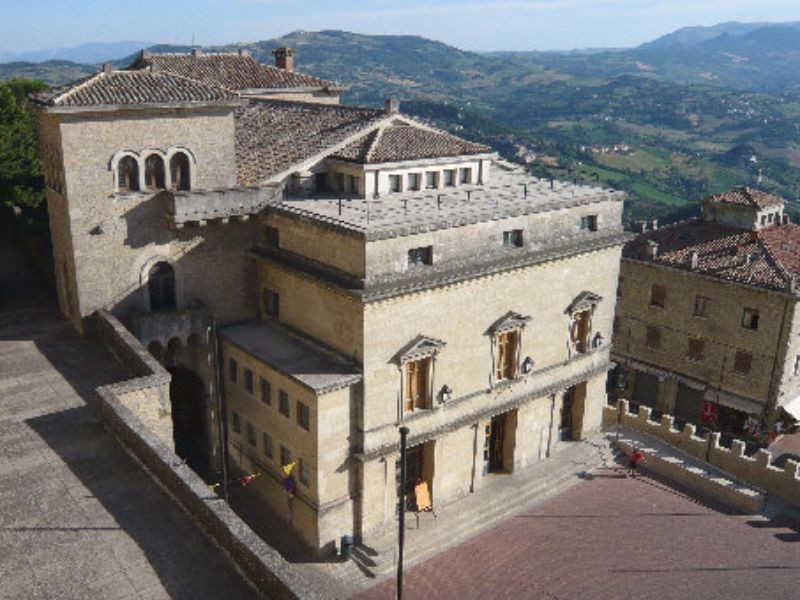San Marino
The Most Serene Republic of San Marino is a must-see destination for lovers of history and for those who love picturesque panoramas. One of the world’s smallest and oldest republics, San Marino isn’t Italy but it is surrounded by Italy’s Emilia-Romagna and Le Marche regions near the Adriatic Sea, making it an easy day trip from Bellaria Igea Marina.
Founded in the 4th century AD, San Marino prides itself on being one of the world’s smallest, oldest independent states. The country is tiny, with a total population of around 30,000 people and is home to UNESCO world heritage sites like Mount Titano (San Marino’s highest point), San Marino City and Borgo Maggiore. San Marino, Mount Titano.

The San Marino stronghold on top of the Mount Titano.
The legendary origin of San Marino is connected with the arrival in 257 A.D on Mount Titano, of Marino, later made a saint, coming from the island of Rab, in modern-day Croatia, at the time a part of Roman empire. Marino arrived in nearby Rimini to work as a stonecutter and subsequently he decided to move to Mount Titano to live as a hermit. Marino lived there, surrounded by people attracted by his charisma, until his death in 301 A.D. The legend says he received Mount Titano as a gift from the legitimate owner, in favour of whom he had performed a miracle and subsequently he left it to those who had lived around him. Hence the mythical foundation of the Republic, which, still today, coincides with San Marino’s death year.
After the death of its founder, the mount Titano, was under the indirect political control of the Pope and of the Bishop of the nearby Montefeltro area. Only starting from the late 13th century, during the age of the Communes, San Marino’s citizens started to slowly free themselves from this dominion, by developing their own statutes, judiciary and political bodies able to autonomously manage the community.

Statue of San Marino located in Piazza della libertà(freedom square)
San Marino is governed by a Constitution (Leges Statutae Republicae Sancti Marini), a series of six books written in Latin in the late 16th century, considered to be the earliest written constitution, still in effect.
The country’s economy mainly relies on finance, industry, services and tourism. It is among one of the wealthiest countries in the world in terms of GDP (per capita), with a highly stable economy.
The old-town centre is located on the top of Mount Titano, 750 m above sea level. The mighty medieval stone walls enclose the original settlement, which is likewise entirely built of stone and closed to traffic. The old-town centre is criss-crossed by narrow streets lined with buildings and monuments.

Old town at night
The Three Fortresses at the top of the Mount give San Marino its best-known image and are linked by a path that runs along the entire ridge of the mountain. Inside the second Fortress is the museum of historical weapons. Located in the higher part of town is the Basilica del Santo, where a number of institutional ceremonies are performed and the Church of San Pietro, with the bed of San Marino.

San Marino’s Basilica
Near the main entrance gate to the old-town lies the Church of San Francesco with attached art gallery, dating back to the 14th century. Not far away is the Church of the Cappuccini and the State Museum housed in the recently-restored Palazzo Pergami. Piazza della Libertà is the heart of the country’s institutional life. Here stands the Public Palace (1894), where the Great and General Council (the Parliament) sits.

San Marino, public Palace at sunset
The public can visit the room where the Parliament sits and admire the large fresco by the Roman artist Retrosi, dating back to the late-19th century.

San Marino, in the painting of Retrosi
Behind the Public Palace lies the beautiful Cava dei Balestrieri, where traditional events are staged, involving the crossbowmen and flag-wavers of San Marino.

Medieval reenactement
In Contrada Omerelli are a series of historical buildings that currently house a number of ministries and the Ancient Monastery of Santa Chiara dating back to the early17th century, which is now the seat of San Marino University. Another outstanding building is located in Piazza Sant’Agata, the Teatro Titano, a charming balconied theatre built around 1750 and totally restored in 1941.

Titano theatre
Like its name, “Most Serene Republic of San Marino,” implies, the tiny country is a green oasis, the perfect place to relax and enjoy the tranquil surroundings. Complete with unspoiled land, rolling hills, wineries and fortresses, San Marino is a great (and less crowded) alternative to the Tuscan countryside. On a clear day, you can even steal a view of the nearby Riviera Romagnola beaches and of the Adriatic sea!
Coming from Italy to San Marino is quite easy: there is no border control, so you don’t need your passport to enter but you can ask for a stamp in the tourist department as a souvenir! The local currency is the Euro and the official language is of course Italian so even this tour can be turned in am mazing opportunity to learn Italian not in Italy but very close to Italy!!! San Marino is as well a tax-free shopping heaven! Despite its tiny size, the country boasts hundreds of chic shops and boutiques, malls and outlets.
As an independent state, San Marino has its own military, one of the smallest in the world! The fascinating tradition of the changing of the guard is kept from April to September, every half hour from 8am to 6pm at the Palazzo Pubblico.

Change of the guard ceremony.








